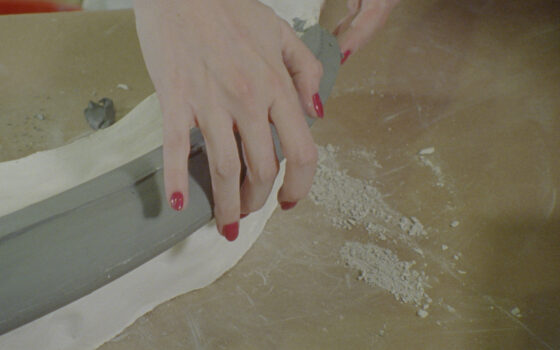Those That, at a Distance, Resemble Another (Jessica Sarah Rinland, UK/Argentina/Spain) — Wavelengths
By Darren Hughes
Published in Cinema Scope #80 (Fall 2019)
A key to Jessica Sarah Rinland’s newest film, Those That, at a Distance, Resemble Another, can be found in the closing credits: along with cinematography, editing, and foley, Rinland is credited as “Voice” and “Pink-Nailed Ceramicist” (the nail designer is also credited). When we first see her hands they’re covered in cracked, grey ceramic slip, like gloves. Rinland then cuts to still photos of an elephant’s grey, cracked face, followed by a high-angle shot of Rinland’s clean hands as she vacuums dust from a 3D printer, gradually revealing one section of what will, over the course of the film, become a museum-quality replica of a century-old tusk. I say “century-old” because, as Rinland vacuums, she explains that the original was donated to the museum in 1900 and came from an elephant that was poached in Malawi. Because she is not identified onscreen as the speaker, and because the form of the film constantly calls attention to the process of its own making—for example, Rinland claps for sound before the vacuum shot and bridges scenes that take place in interior locations with processed sounds of insects and fauna—we must take on faith the validity of every claim. Rinland, the screenwriter, remains in control.
Those That, at a Distance, Resemble Another ends with one more replica for us to consider: a 3D-rendered animation of the tusk. How does it compare to the original? To the ceramic piece? How should we judge the value of each? Rinland is begging the classic ontological questions of art, but that line of interpretation is something of a red herring. Rather, the film seems designed to ensnare viewers in the unspoken fetishistic pleasures of collecting, archiving, and displaying—the same pleasures that drive the economies of poaching and museum-building. Beginning with the whispered poetry recitation in Darse Cuenta, Rinland has consistently used a number of formal techniques that have, in recent years, become associated with ASMR. Those That, at a Distance, Resemble Another is a comprehensive catalogue of triggers: hands turning pages of a book, the sounds of dripping water and spray bottles, soft brushes wiping surfaces clean, unboxing, cutting with scissors, crinkly plastic wrap, drawing and tracing, demonstrative hand gestures, latex gloves, rubbing with sponges, and fingers pulling lint from a vacuum bag.
Nearly an hour into the 67-minute film, Rinland inserts a rare wide shot of a man clumsily stacking tusks and ivory carvings on the bottom shelf of a storage closet, and the noisy banality of his work breaks the long-sustained, hypnotic reverie. He’s not alone. Other workers make small talk, scrub plastic bins, and sweep floors in sterile back rooms. Rinland then catalogues, via red-on-black text, the names of the people with whom she collaborated at a dozen museums. Only in the penultimate shot, when the workers wander outside to enjoy a snack of watermelon, do they appear to truly experience the wonders of the natural world.
Darren Hughes


